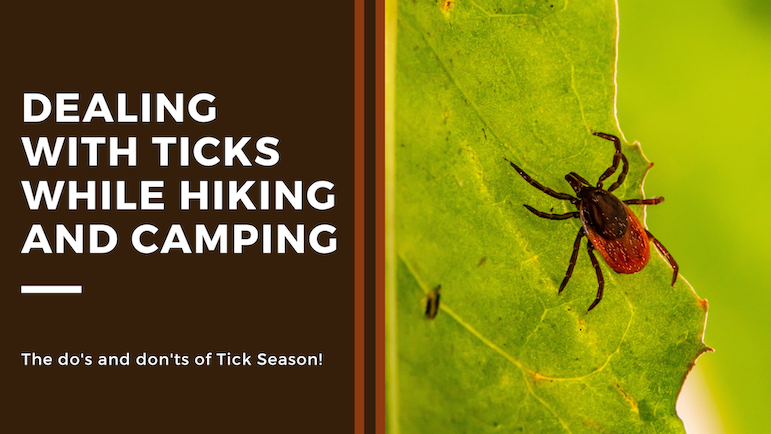Dealing With Ticks While Hiking And Camping
It’s the first day of Spring, and along with the awakening of flowers and cute little birds, we also have less friendly creatures emerging from the grass.
No matter how careful you are, ticks are something that any hiker will eventually have to deal with. These creepy crawlies hide in bushes and tall grass, waiting for a potential host to walk by. They then latch on and have themselves a warm bloody meal.
Given that an encounter is almost inevitable, how do you reduce those chances and get rid of the tick once it’s turned you into dinner? Let’s find out.
# Avoiding Ticks
If you’re spending a regular amount of time on the trail you will eventually get a tick on you.
But even though they will eventually catch you, you get away a little longer by taking some simple precautions:
Tuck your pants in your boots and your shirt in your pants. This will make it more difficult for ticks to find bare skin and a place to hide.
Use a good tick repellant.
Ticks are more abundant and active during the spring and summer months. Make sure to be extra careful!
Ticks prefer forests and tall grass. Pay attention when going off-trail in these areas!
Avoid brushing against bushes. It's a perfect way for a tick to latch on to you.
Careful when sitting down on the ground, make sure the area is clear.
If you have equipment like a backpack on the ground for some time, give it a shake and a look to make sure no one is hitching a ride on your stuff.
At the end of the day, always check your entire body for ticks! Ticks prefer dark and warm places to hide, so give extra attention to the armpits, scalp, groin and bottom areas, as well as your legs and behind your knees .
If you’re hiking with dogs, make sure to check them properly as well, just in case they carry unwanted visitors.
# What to do in Case of a Bite
You’re checking your body after a day of hiking, and you find a tick. What to do now?
First things first, don’t panic. Finding a tick is never a fun experience, but removing them is normally a breeze. Just follow these tips:
Remove the tick as soon as you can. The longer the tick remains in place, the more chances there are of it transmitting a disease if its infected.
Use a tick remover. Pass the arched tip under tick, grab it and pull gently until it pops off. Keep in mind that this won’t harm the tick and they are ridiculously difficult to kill, so try not to drop it, especially not in a tent. I did it, and it’s really not fun to look for it after.
Normal tweezers can work as well, just grab the tick by the mouth and slowly pull it off. Remember to be gentle, a tick can regurgitate its meal when disturbed, increasing the risk of it transmitting a potential disease.
If you don’t have a pair of tweezers or tick removers you can use your fingernails, but this is a last measure. Grab the tick between two fingernails and pull it off. This is not the ideal way to do it, as it not only increases the risk of disease, it also risks leaving the tick’s mouthparts embedded in your skin, after which it needs to be removed like a splinter.
After removing the tick, clean the area with rubbing alcohol or disinfectant. Even if the tick was not carrying a disease, the bite can still get infected, so treat it like you would any open wound and make sure it is properly cleaned.
Keep an eye on the bite for a few days. If you develop a rash or become ill, be sure to visit a doctor. Ticks can be vectors for a huge number of diseases, most commonly Lyme disease. This disease in particular can be recognised by the bullseye rash that forms at the site of the bite. It is easily treatable with antibiotics if detected early, but can become chronic and cause severe damage if left untreated.
I hope I haven’t creeped you out too much with this article.
Ticks are unfortunately an annoying but ever present part of the outdoors. Follow these tips and you’ll at least reduce the chances of a meeting, and you’ll be prepared for when they finally get you.
Sweet nightmares and until next time this is Luca, signing off.
Other articles you might enjoy:
𝘿𝙞𝙙 𝙮𝙤𝙪 𝙚𝙣𝙟𝙤𝙮 𝙩𝙝𝙞𝙨 𝙖𝙧𝙩𝙞𝙘𝙡𝙚 ?
𝘠𝘰𝘶 𝘤𝘢𝘯 𝘴𝘢𝘷𝘦 𝘰𝘳 𝘱𝘪𝘯 𝘵𝘩𝘪𝘴 𝘪𝘮𝘢𝘨𝘦 𝘴𝘰 𝘵𝘩𝘢𝘵 𝘺𝘰𝘶 𝘤𝘢𝘯 𝘢𝘭𝘸𝘢𝘺𝘴 𝘭𝘰𝘰𝘬 𝘣𝘢𝘤𝘬 𝘰𝘯 𝘵𝘩𝘦𝘴𝘦 𝘵𝘪𝘱𝘴 !







